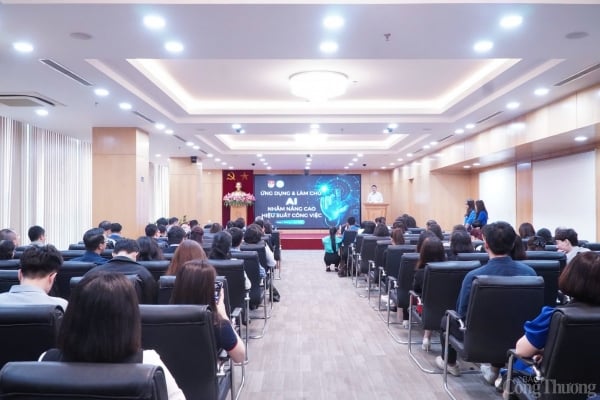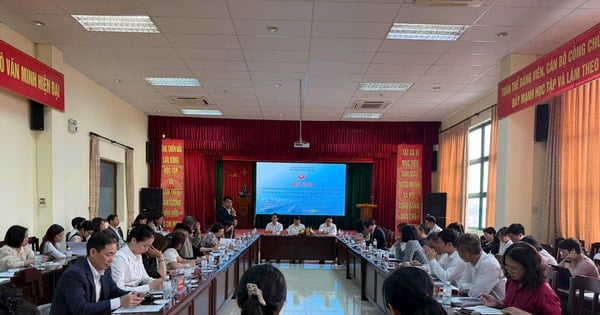Vietnam's e-commerce market in 2024 will reach 22 billion USD, up 25% compared to 2023. The rapid growth of e-commerce also creates a lot of competition.
Not exactly "glorious land"
The market has been witnessing a strong shift from traditional retail stores to e-commerce platforms. While in 2018, e-commerce revenue from direct transactions between businesses and consumers (B2C) in Vietnam only reached about 8 billion USD, by 2019, it had surpassed the 10 billion USD mark. Revenue continued to increase to 11.8 billion USD in 2020 and 16.4 billion USD in 2022. With revenue reaching 20.5 billion USD in 2023, the proportion of B2C e-commerce revenue accounted for about 7.8 - 8% compared to the total retail sales of goods and consumer services revenue nationwide. In 2024, the proportion of B2C e-commerce revenue continued to account for 8 - 9% and reached 22 billion USD.
 |
| The e-commerce market is accelerating strongly. Photo: P. Thao |
The rapid growth of e-commerce platforms has forced a series of traditional stores to close because they cannot compete with online platforms, making it quite easy for the first sellers on this platform to do business. However, at present and in the future, e-commerce will no longer be a "promised land" for all businesses, when cross-border e-commerce is developing rapidly. With millions of retailers participating, this is a very competitive environment.
In reality, according to many businesses, the challenges they face include: Limited knowledge and digital skills; low competitiveness; lack of market information and issues related to legal barriers, tariffs, logistics, payments; language, etc.
Mr. Pham Anh Tuan - Deputy General Director of Vietnam Post Corporation - said that an e-commerce platform needs many floors to operate. To be able to go live, there are many issues, such as: Marketing, ensuring superior delivery management... Cross-border e-commerce also involves adapting to the culture and laws of the host country... along with many requirements that businesses must try really hard to meet.
According to Mr. Tran Quoc Bao - Deputy General Director of KIDO Group, and CEO of E2E e-commerce channel: The 3 core difficulties when businesses participate in the e-commerce market are technology; perseverance and scale.
Experts agree that the biggest problem today is the competitiveness between domestic and Chinese e-commerce platforms. Success or failure depends mainly on the capacity of Vietnamese enterprises in production, business and distribution. If enterprises do not make a breakthrough from production to distribution, combined with protection solutions, Vietnamese goods will lose right at home.
The Ministry of Industry and Trade has also recognized that e-commerce in Vietnam is facing three major challenges: Consumers are facing the loss of personal data security; counterfeit goods, poor quality goods, low safety that are not strictly controlled have been and are besieging, ready to invade our country, affecting both manufacturing enterprises and consumers; and tax loss.
Which way for business?
Despite facing many challenges, switching to e-commerce platforms is an inevitable trend for retail businesses to survive. However, to overcome the challenges, retailers need to have a clear and flexible strategy. First, they need to use tools such as AI and Big Data to thoroughly research the market and competitors to find out their strengths and weaknesses. In addition, they need to build good relationships with customers. Sellers need to take advantage of support tools from e-commerce platforms and loyalty programs to increase customer engagement.
Ms. Dang Thuy Ha - Research Director, Northern Region Representative at NielsenIQ Vietnam - said that price and promotion are the main drivers of e-commerce growth. In addition, brand is the top factor sought by consumers when making a purchase. In addition, online reviews and searches have a great influence when consumers explore new brands. While delivery costs are a major barrier when consumers shop online...
Therefore, to win the e-commerce race, Ms. Ha said, it is necessary to measure trends, competitive performance for the category at the product level and monitor the results regularly; optimize distribution and reduce out-of-stocks with daily e-commerce analytics at the store level; optimize content to improve consumer discoverability, increase search performance, ensure consumers find products that meet their needs; bring quality products, understand consumers and what they are looking for online.
According to Mr. Tran Dinh Toan - Vice President, OSB Group: The gap between enterprises and localities in applying e-commerce is gradually decreasing thanks to support from the Government and domestic and foreign business support organizations. Enterprises in remote areas have more and more opportunities to participate in exports through e-commerce... However, to further improve efficiency, authorities need to organize training programs on e-commerce operation skills, including store management, digital marketing optimization, logistics and payment management.
At the same time, support businesses to grasp new trends, build export strategies through e-commerce in a systematic way; equip businesses with knowledge about new technologies such as Big Data, AI, VR&AR, Blockchain... to optimize operations.
In addition, there is a cooperation mechanism between the State and technology enterprises in building e-commerce infrastructure, logistics, international payments, carbon credit trading floors, etc.
| In order for e-commerce to develop further in the coming years, experts say that it is necessary for ministries and sectors to join hands to come up with many comprehensive strategies and solutions, aiming at goals such as protecting consumer rights; strengthening regional connectivity; green and sustainable development; and narrowing the gap between localities and regions through digital platforms. |
Source: https://congthuong.vn/thuong-mai-dien-tu-duong-dai-khong-may-de-di-365276.html





![[Photo] Looking back at the impressive moments of the Vietnamese rescue team in Myanmar](https://vstatic.vietnam.vn/vietnam/resource/IMAGE/2025/4/11/5623ca902a934e19b604c718265249d0)

![[Photo] "Beauties" participate in the parade rehearsal at Bien Hoa airport](https://vstatic.vietnam.vn/vietnam/resource/IMAGE/2025/4/11/155502af3384431e918de0e2e585d13a)























![[Photo] Summary of parade practice in preparation for the April 30th celebration](https://vstatic.vietnam.vn/vietnam/resource/IMAGE/2025/4/11/78cfee0f2cc045b387ff1a4362b5950f)



























































Comment (0)